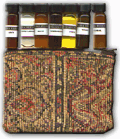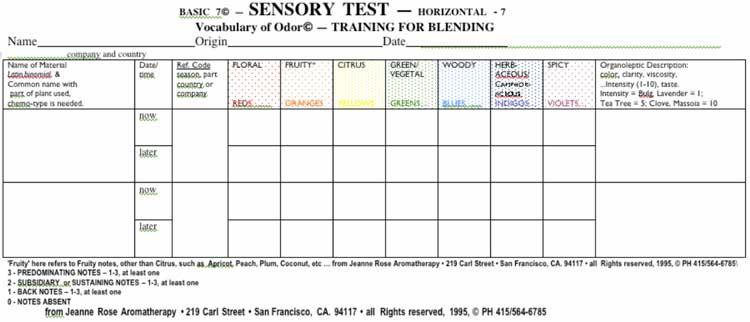
|
|||||||||||||||||||||||||||||||||||||||||||||||||||||||||||||||||
|
|||||||||||||||||||||||||||||||||||||||||||||||||||||||||||||||||
Procedure for Describing Scents: I have in most cases modified and used the simplest Perfumers Full Sensory Guide to describing Odor. This chart slightly modified from the Perfumers Guide is for my aromatherapy students — because we use true essential oils and not synthetics. These named odors are called — the Basic 7-Vocabulary of Odor© (floral, fruity, citrus, green/vegetative, wood, herb/camphor and spice). Where necessary the Intermediate 13 has been used for comparison of like-named odors and the Advanced Vocabulary of Odor using the 28 basic descriptive words is used (from the Natural Perfumery Education class) for the full aromatherapy sensory/descriptive odor profile. For the Basic 7 Scents© the procedure is as follows: Learn the names of the Odors and become familiar with the chart: Floral, Fruity, Citrus, Green/Vegetative, Herbaceous/Camphoraceous, and Spicy. 1. Familiarize yourself with the 7 Basic Odors©. Smell the essential oils or blends in order from the start at 1-7, that is, start at Floral and end at Spicy on individual scent blotters. This is important. Waft don't draft the scents. Look at the bottle, say the name of the scent while smelling it. This connects the nose to the brain via the limbic system. Do this repeatedly for at least one full month. [The Institute of Aromatic Studies has a kit that one can purchase to enable you to familiarize yourself with these odors. $65 + shipping. E-mail info@jeannerose.net.] 2. To verbally describe a new odor, put a drop on your scent blotter. Allow the essential oil to be absorbed by the blotter before wafting under your nose. Waft, don't draft the Scents. Now, go through the Basic 7 scents quickly and within a period of 3 minutes so that olfactory fatigue does not set in. Take note of your first impressions since they are frequently the correct ones. If you work too hard at this, you may get confused. [KIS = Keep It Simple] 3. Carefully smell for each of the scents named and specified in the headings in the order that they are presented: Floral, Fruit-like, Citrus, Green/Vegetative, Woody, Herbaceous/Camphoraceous and Spice. Ask yourself each time "Is there this (odor name) note in this essential oil?" If the answer is 'no', mark the number 0 in the box meaning it is absent. If the answer is 'yes', estimate the strength of the note and record it by using 3, 2, or 1. The #3 note, the Predominating Note, is a note which characterizes the entire scent and is the most predominant, the #2 note, the Subsidiary Note, that is, it is perceptible and important but not the principle note, and the #1 note is a Back Note, that is barely perceptible. There can be more than one Predominating note, more than one Subsidiary note, more than one Back note and more than one Absent note. However, there has to be at least one of each. Please look at the chart given in the kit and review the material as an example of the Full Sensory Test. 4. Use a pencil to record your results as your ideas may change as you go through the chart. When you have gone through the 7 Basic Odors, you can go back and record your findings in pen. You may also add words, adjectives, to the numbers to show the differences between, for instance, a tropical wood and a conifer wood is a wood odor but a different 'tint' or ‘hue’. Other descriptives can be used as well as using adjectives. 5. Think of the 7 Basic Odors© as the 7 basic colors. Colors come in many shades, hues, and tints as do the odors. Colors match the notes, scents and chakras. Red colors (Floral) comes in many shades/tints as does Orange colors (Fruit), Yellow colors (Citrus), Green colors (Green/Vegetal), Blue colors (Wood), Indigo colors (Herbaceous/ Camphoraceous) and Violet colors (Spice). 6. Repeat the sensory smelling of each oil again in 1 hour from the same blotter and note the changes or losses in odor strength/intensity or gain or loss in notes. 7. Also make note of where or if the scent strikes any part of your body in any particular way. Do you hear particular sound when you see a particular color or smell a particular scent? That is called synesthesia. Make a note of it. IA&HS • 219 Carl St. • San
Francisco, CA 94117 • ©all rights reserved by Jeanne Rose ©2000 •
Basic 7 -Vocabulary of Odor By a student of the Jeanne Rose Blending Class Odors have an impact on our mental and physical states through our sense of smell. We smell odors by breathing in the air around us through our nose, and passing it by the olfactory epithelium. This is a special membrane in our nose that is covered with millions of nerve ends, and has the ability to selectively absorb chemical constituents, and transmits stimulus onto the limbic system. The limbic system is responsible for regulating our emotions, our motivation, our memory and creativity, as well as our autonomic nervous system. In order to consciously monitor and determine the effects of odors on ourselves, we need to be able to sort out and identify the major and minor constituents based upon the odors. We need to use a common language. In many cases, odors have a complex range of chemical constituents that can be hard to resolve either analytically or organoleptically. Fortunately, our nose is a very sensitive instrument that can unscramble the odor's chemical constituents. When we use our nose to identify the odor's constituents, we are also scrutinizing the response of our limbic system to the odor. We use descriptive words (in a common language) to express the odor's/scents elements, such as Floral, Citrus, or Spicy. Most people can associate likewise with these descriptions when using a common set of selected blended scents, and thus it is a good system to use for describing these elements universally. If we learn the same scents in a common language, we have a resource by which we can describe the odor of single oils or of blended oils. The "Vocabulary of Odor©" systems was originally adopted from the Perfumers Guide, and then developed by Jeanne Rose for pure essential oils to categorize the seven basic common odor elements. The seven Basic Odors are Floral, Fruity, Citrus, Green/Vegetal, Woody, Herbal/Camphor and Spicy. These are then used by determining the strength of each in any oil or blend — as Predominant, Subsidiary, Back and Absent. This set works well as an initial training aid and screening of any scent. As experience and skill is gained, the original set of seven elements can be expanded into the 13 Vertical Intermediate [Floral Powder, Honey, Fruity, Citrus, Conifer, Mint, Wood, Smoky, Earthy, Herbaceous, Camphoraceous, Spicy] (to be able to analyze the difference between like-named oils); and then the 28 elements in the Circular Advanced Vocabulary of Odor to do a more advanced detailed analyses:
AUTHOR: Jeanne
Rose has been teaching and researching natural remedies for 33
years, beginning with her first book,
Herbs
& Things, now in its second edition.
To get in touch, to purchase the books, to understand
aromatherapy, herbalism, hydrosols and essential oils, to sign up
for the in-person
Seminars with Jeanne Rose, visit her website at www.jeannerose.net or e-mail for information at info@jeannerose.net.
Jeanne Rose also teaches a distance learning program,
home-study courses both in
Herbalism and
Aromatherapy. She is
Executive Director of the Aromatic Plant Project and can be reached
at info@hydrosols.net. You
may also call 415/564-6785. Institute of Aromatic &Herbal
Study by Jeanne Rose • 219 Carl St. • San Francisco, CA 94117 • Please
Check back often as we add more articles to the Jeanne Rose Website! |
|
||||||||||||||||||||||||||||||||||||||||||||||||||||||||||||||||
|
|
|||||||||||||||||||||||||||||||||||||||||||||||||||||||||||||||||
| © 1999, 2000, 2001, 2002, 2003, 2004, 2005, 2006 Jeanne Rose, All Rights Reserved. Web Design by PS Design ~ Updated 11/01/06 |

